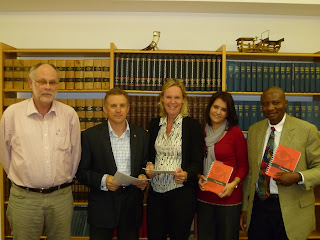Save the Children Sweden (SCS) and SIDA recently signed an agreement that will see two civil society organisations in Namibia participate in legislative reform. The focus of the two year project is the Child Care and Protection Bill that is currently under review in Namibia. The project aims at increasing awareness among parliamentarians, the judiciary, government officials as well as children and their caregivers of the Child Care and Protection Act of Namibia with a specific focus on four regions.
Save the Children Sweden will work with two Namibian civil society organisations, Legal Assistance Centre (LAC) and Ombetja Yehinga Organisation (OYO), to implement the project. LAC is a national organisation promoting human rights in Namibia with a focus on information and advice, litigation, education and training, research and law reform and advocacy. SCS will also work with OYO, who delivers a range of programmes using information, education and communication (IEC) resources created by and for young people, including the OYO magazine, OYO Regional and National Drama Tours and OYO DVDs. Save the Children Sweden will provide technical and financial support to these organisations to implement the activities.
The project will first undertake advocacy and awareness raising events in order to promote the passage of the Bill. There will be also training conducted with magistrates to ensure their understanding of the Bill and source their input. The project will also engage with in and out of school children, teachers and caregivers to ensure that these children have the information necessary to claim their rights.
In implementing the project, the partners will not cover all aspects of the very comprehensive Child Care and Protection Act, but rather focus on a number of key provisions in the Act. It is envisaged that the project will yield the following results:
· The Child Care and Protection Act is passed in Parliament during 2011
· At least 50 magistrates understand the content of the Child Care and Protection Act and its implications on their duties
· At least 10,000 children in Khomas, Kunene and Erongo have the information necessary to claim their rights as stipulated in the Child Care and Protection Act
· LAC and OYO engage with civil society organisations regionally in order to share lessons learnt and best practices
The two year project in Namibia will also provide an opportunity for Save the Children Sweden, OYO and LAC to meet twice a year to assess progress against objectives and results, reflect on lessons learned and good practices and to develop a joint strategy for how to take the project further in 2013 and beyond
Background
As one strategy to address children’s rights in Namibia, the government is strengthening the legal framework for the protection of children by finalizing the Child Care and Protection Bill. The Bill contains a wide range of provisions to protect and promote the well-being of children, including early intervention services, procedures for removing endangered children from the home, foster care, adoption, child trafficking, child headed households and children’s courts. When adopted, the Bill will provide a more comprehensive framework for child protection in Namibia. It is also anticipated that the government will then develop regulations to further define the framework for its implementation.


